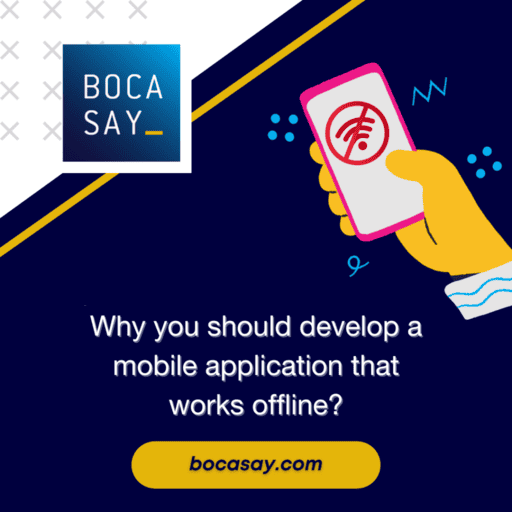Why You Should Develop a Mobile Application That Works Offline?
Gone are the days when companies simply wanted to make their applications compatible with 4G or 5G technology. Today’s users are merciless against mobile apps that are not optimized for limited connectivity.
Add to that the fact that recent periods of lockdown around the world have made people more dependent on the internet, and the inability to use applications offline is a bad sign for the application industry.
Our offshore IT oprojects agency knows all too well the reasons why your mobile applications need to work offline, and that’s what we’re going to discuss in this article.

Why would you want to develop mobile applications that work offline?
Network issues, battery limitations, international users working in different regions and time zones, and many other factors make it necessary for mobile applications to have offline capabilities.
This offline mode is also an important competitive advantage for your business, especially when it comes to applications such as GPS navigation, messaging applications, medical assistance applications or banking applications.
No matter how much users like your application, the lack of offline functionality in your application can lead to its abandonment.
By integrating offline mode into your application, you can continue to use the basic functionality of your application even if you lose connectivity.
The benefits of offline functionality
A poor Internet connection can lead to a disappointing user experience.
A poor UX (user experience) is prohibitive and many consumers uninstall or stop using the application in question.
Here are some benefits of integrating an offline mode for your app that can help you improve your user experience and maximize your business benefits:
- Users will be able to access the app’s functionality even if they are in a low connectivity area.
- The offline mode of an application eliminates any risk of delays. You can continue your daily activities with flexibility.
- When users know the app is reliable in low connectivity areas, they become more loyal.
- Users can stay connected to the app even if they are traveling.
- Offline apps require very little loading time.
- They are less likely to drain the user’s device battery.
- When stored locally, data has little to no chance of being breached.
𝔻𝕠 𝕪𝕠𝕦 𝕙𝕒𝕧𝕖 𝕒 𝕕𝕖𝕗𝕚𝕟𝕚𝕥𝕖 𝕘𝕠𝕒𝕝? 𝔻𝕠 𝕪𝕠𝕦 𝕟𝕖𝕖𝕕 𝕥𝕠 𝕓𝕖 𝕒𝕕𝕧𝕚𝕤𝕖𝕕? 𝕆𝕦𝕣 𝕥𝕖𝕒𝕞𝕤 𝕒𝕣𝕖 𝕒𝕧𝕒𝕚𝕝𝕒𝕓𝕝𝕖 𝟟/𝟟 𝕥𝕠 𝕒𝕔𝕔𝕠𝕞𝕡𝕒𝕟𝕪 𝕪𝕠𝕦 𝕚𝕟 𝕪𝕠𝕦𝕣 𝕕𝕚𝕘𝕚𝕥𝕒𝕝 𝕥𝕣𝕒𝕟𝕤𝕚𝕥𝕚𝕠𝕟. ℂ𝕠𝕟𝕥𝕒𝕔𝕥 𝕦𝕤 𝕗𝕠𝕣 𝕞𝕠𝕣𝕖 𝕕𝕖𝕥𝕒𝕚𝕝𝕤, 𝕚𝕥’𝕤 𝕗𝕣𝕖𝕖 𝕒𝕟𝕕 𝕨𝕚𝕥𝕙𝕠𝕦𝕥 𝕔𝕠𝕞𝕞𝕚𝕥𝕞𝕖𝕟𝕥!
What are the essential elements of an offline mobile application?
The elements you need to consider when implementing offline mode in your application are:
1. An offline user interface
Clear communication is the key to a successful customer experience strategy. You need to keep this in mind when designing the user interface for offline mode. This involves:
- Reminding users that the offline state is not an error state.
- Informing users when the application detects weak or unavailable network conditions.
- Not displaying error messages that are nothing more than jargon.
2. Make static information available
In applications that operate with limited or offline connectivity, static information is downloaded and stored locally when first loaded. This data is not changed frequently.
This is the case with Google Maps. This application has an offline feature that allows users to navigate locations on the Google map and access a certain level of detail, even when the connection is interrupted.
3. Create a cache of commonly used dynamic data
Unlike static caching, dynamic cache data is expected to be updated frequently.
To enable this in an environment with limited or no connectivity, user information is temporarily stored in the local cache (this process is most often seen in PWAs). This prevents a blank screen during offline mode.
This approach is widely used by many gaming and social media applications.

4. Establish a data synchronization frequency
When an application is used offline, you need to synchronize some actions and data with the server. This synchronization takes place as soon as an Internet connection is available.
Reconnecting to the Internet and synchronizing too often drains the battery of the device. But if an application only syncs occasionally, users may miss some critical updates.
App developers need to find the right balance between the two.
For example, if users are using your app for business purposes, define the slots in their schedule that are most conducive to downloading data. The better the data connection, the shorter these slots will be.
5. Manage sensitive data
Users’ private information cannot be deleted for security reasons.
Downloaded data, such as blog posts, logos, etc., are stored in the cache folder of the user’s device, so there is no need to download them every time the user accesses and uses this content.
By pressing the “Back” button or checking the browser cache, you can see the cached information. But this practice puts sensitive information like usernames and credit card details at risk. So make sure that sensitive information is not cached.
Why trust Bocasay to develop your offline application?
Bocasay is an offshore IT projects agency. This means that its teams are not composed according to the talents available in a certain geographical area. On the contrary, our developers, selected internationally, have the experience and know-how necessary for the development of your digital project. Website, application, software, our collaborators are trained to work with the Agile and Scrum approach, to carry out your project, from A to Z. Contact us for a quote, it’s free and without obligation!